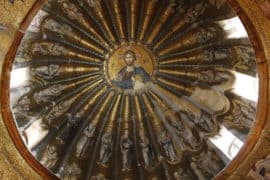Although only Matthew and Luke assert the “virgin birth” of Jesus, and the teaching is found nowhere else in the New Testament, the belief that Mary’s pregnancy resulted from a divine act of God without any male involvement developed into a fundamental theological dogma in early Christianity. For millions of Christians any suggestion that Jesus was conceived through the normal process of human sexual reproduction, even if somehow sanctified by God, is viewed as scandalous if not outright heresy. But history, by its very nature, is an open process of inquiry that cannot be bound by the dogmas of faith. Historians are obligated to examine whatever evidence we have, even if such discoveries might be considered shocking or sacrilegious to some. The assumption of the historian is that all human beings have both a biological mother and father, and that Jesus is no exception. That leaves two possibilities—either Joseph or some other unnamed man was the father of Jesus. Is it possible that a more historical reading of these two birth stories in the light of all our surviving evidence might reveal to us a profoundly human Jesus that dogmatic faith has obscured? Could such a revelation end up being as spiritually meaningful as the belief in the “virgin birth”—a teaching that many sincere Christians have problems accepting literally?[i]

Scholars who question the literal truth of Matthew and Luke’s birth stories have suggested that they are a way of affirming the divine nature of Jesus as “Son of God” by giving him an extraordinary supernatural birth. This idea of humans being fathered by gods is quite common in Greco-Roman culture.[ii] There was a whole host of heroes who were said to be the product of a union between their mother and a god—Plato, Empedocles, Hercules, Pythagoras, Alexander the Great and even Caesar Augustus. In text after text we find the idea of the divine man (theios aner) whose supernatural birth, ability to perform miracles, and extraordinary death separate him from the ordinary world of mortals. These heroes are not “eternal” gods, like Zeus or Jupiter. They are mortal human beings who have been exalted to a heavenly state of immortal life. In the time of Jesus their temples and shrines filled every city and province of the Roman Empire.[iii] It is easy to imagine that early Christians who believed Jesus was every bit as exalted and heavenly as any of the Greek and Roman heroes and gods would appropriate this way of relating the story of his birth. It was a way of affirming that Jesus was both human and divine. Modern interpreters who view the stories in this way usually maintain that Joseph was likely the father and that these supernatural accounts were invented later by Jesus’ followers to honor Jesus and to promote his exalted status in a manner common to that culture.
But there is another possibility; an alternative explanation as to what might be behind these “virgin birth” accounts. And it has some compelling evidence in its favor. When you read the account of Mary’s unsuspected pregnancy, what is particularly notable in both texts is an underlying tone of realism that runs through the narratives. These seem to be real people, living in real times and places. In contrast, the birth stories common in Greco-Roman literature have a decidedly legendary flavor to them. For example, in Plutarch’s account of the birth of Alexander the Great his mother Olympias got pregnant from a snake, announced by a bolt of lightning that sealed her womb so that her husband Phillip could not have sex with her.[iv] Granted, both Matthew and Luke include dreams and visions of angels but the core story itself—that of a man discovering that his bride-to-be is pregnant and knowing he is not the father—has a realistic and thoroughly human quality to it. The narrative, despite its miraculous elements, “rings true.”
What if the virgin birth stories were created, not to present Jesus as a divine Greco-Roman style hero, but to address a shockingly real situation—Mary’s illegitimate pregnancy? All four women that Matthew mentions in his genealogy had sex out of wedlock and at least two of them became pregnant. By naming these particular women Matthew seems to be implicitly addressing Mary’s situation.
There are some indications in our gospels that the charge of illegitimacy was circulating behind the scenes. Mark is our earliest gospel, written around 70 AD. He includes an important scene in which Jesus returned home to Nazareth as an adult. There was a buzz about him among the townsfolk. Notice carefully their language:
Is not this the carpenter, the son of Mary and brother of James, and Joses, and Judas and Simon? And are not his sisters here with us? (Mark 6:3)
Matthew uses Mark as a source and includes the same story, but notice how he very cleverly rephrases things:
Is not this the carpenter’s son? Is not his mother called Mary? And are not his brothers James and Joseph and Simon and Judas? And are not all his sisters with us? (Matt 13:55)
This subtle but critical shift in wording is absolutely telling:
Is not this the carpenter, the son of Mary (Mark)
Is not this the carpenter’s son? Is not his mother called Mary (Matthew)
Calling Jesus “the son of Mary” indicates an unnamed father. In Judaism children are invariably referred to as sons or daughters of the father—not the mother. Mark never refers to Joseph at all, by name or otherwise. He avoids the paternity issue altogether. There has to be some good reason for this silence. Matthew, in contrast, is quick to reshape Mark’s wording so that the illegitimacy issue is not even hinted at. We even find that later Greek manuscripts of Mark’s gospel try to “fix” the scandal by altering the text to read “the son of Mary and Joseph.” Here we have evidence of a progressive move to mute or play down the scandal that had been familiar in the hometown village of Nazareth decades earlier. Rumors and gossip die hard and seldom completely disappear.
In the Gospel of John things are even more explicit. At one point Jesus was in Jerusalem sparring with his Jewish critics. The conversation became very heated and almost turned violent. One of their responses to Jesus was the startling assertion—“We were not born of fornication,” as if to imply, as you were (John 8:41). Something is clearly going on here. This was a very low blow: an obvious attempt to undermine Jesus’ standing by reference to a rumor about his illegitimate birth. In a 4th century AD Christian text called the Acts of Pilate, which might have origins reaching back to the late 2nd century, there is an account of Jesus’ trial before Pilate. One of the charges of his enemies is “you were born of fornication.” No one takes the text as a historical record of the trial, but it does witness to the longevity of the illegitimacy charge. Whoever wrote the text found it necessary to construct a trial scene that addressed the same charge we encounter in the 1st century gospel of John.
John mentions Joseph only twice, and he provides no birth story at all.[v] Why such reluctance to openly refer to someone’s father? In a passage roughly equivalent to Mark’s we read:
Is not this Jesus, the son of Joseph? Do we not know his father and mother? (John 6:42).
Once again, there appears to be the slightest hint of something irregular. Why name Joseph—then redundantly add, “Do we not know his father and mother”? Coupled with the other text about being “born of fornication,” the illegitimacy charge is more than implicit.
Surely it is no accident that Mark and John, the two gospels that say nothing about Jesus’ birth, and little or nothing about his father, seem to preserve for us these subtle hints of the charge of illegitimacy. Both Matthew and Luke try to mitigate the issue by claiming Jesus was conceived by the “holy spirit,” but both of them freely admit that Joseph was not the father. And that is the point. The notion of illegitimacy is a consistent element found in all four New Testament gospels. Each seems to agree—Joseph was not the father of Jesus.
This charge of illegitimacy is not limited to these four gospels. The Gospel of Thomas was discovered in upper Egypt at a place called Nag Hammadi by an Arab farmer who was digging in the area for fertilizer. It had been sealed in a clay jar and buried in a field, along with a dozen other lost Christian texts, all written on papyri in ancient Coptic. It was likely hidden in the late 4th century to protect it from orthodox Christians who would have destroyed it as “heretical.” Many scholars date it as early as the 2nd century AD. It is clearly the most precious lost Christian document discovered in the last 2000 years. It contains 114 sayings of Jesus. Some have called it a “fifth Gospel” in that it supplies so many missing pieces of Jesus’ teaching—otherwise lost and forgotten. Toward the end of the collection, in Saying 105, Jesus tells his disciples:
One who knows his father and his mother
will be called the son of a whore.[vi]
Many scholars have found in this cryptic saying an echo of the ugly label that Jesus had faced throughout his life—namely that his mother Mary had become pregnant out of wedlock. The Gospel of Thomas has no birth stories or references to Joseph or to the virgin birth but here in this text we appear to have another reference to the illegitimacy story. The implication is that the charge was unjust and that Jesus knew the circumstances of his birth as well as the identity of his unnamed and absent father.
So, if Jesus’ father was not Joseph who might it possibly have been? And what circumstances led to Mary being accused of fornication and labeled a “whore”? In terms of any historical certainty we probably will never know. If we were filling out Jesus’ birth certificate we would have to put down “father unknown,” but there is another possibility that deserves further exploration that I will cover in the next post.
Continue with Part 5 here . . . .
[i] The degree to which a literal interpretation might be taken is best illustrated by the claim of the late amateur archaeologist Ron Wyatt to have located the true site of the crucifixion, to have recovered some of the dried blood of Jesus, and by a lab test demonstrated that Jesus had no father. According to Wyatt the cells contained only 24 chromosomes—22 autosomal, one X, and one Y chromosome—rather than the normal 46 (https://www.wyattarchaeology.com/ark.htm). A anthropology colleague of mine pointed out that although such an idea was a biological absurdity, if one imagined it might be possible the individual would be the most physically deformed creature in the history of the planet—having just half the normal chromosomes needed for normal development.
[ii] For textual examples with some short notes see my UNC Charlotte website: https://www.religiousstudies.uncc.edu/jdtabor/divine.html
[iii] Jews were not immune to such ideas, though Jewish texts that relate such stories invariably affirm that the child, though conceived supernaturally, or divinely announced, was the offspring of the husband. Most typically a woman who had not been able to bear children was told she would and her husband had some type of confirming dream. For example, there is a text in the Dead Sea Scrolls where Lamech, the father of Noah, suspected his wife has become pregnant through an angel, but was then convinced by her that he was indeed the father (Genesis Apocryphon 3).
[iv] Plutarch, Life of Alexander 2-3.
[v] John 1:45 and 6:42.
[vi] Translation is my own. The term “whore” (porne) in this context is a term of slander for one guilty of sexual immorality or unfaithfulness.









Comments are closed.